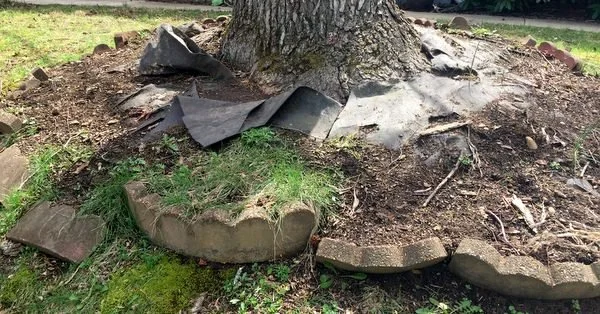Weed Barrier: Why Bother?
Very ugly: weed barrier emerging from the soil to embarrass the homeowner…
By Annie
In landscape design, weed barrier, also known as landscape fabric or weed control fabric, has historically played a crucial role in maintaining a tidy and low-maintenance outdoor space, and in separating clients from their money with empty promises of a weed free landscape.
The idea is that weed barrier is a material placed beneath mulch or gravel to prevent weed growth, making it a popular choice for gardeners and landscapers seeking to minimize weed infestation while reducing the need for herbicides and manual weeding.
The primary purpose of weed barrier is in theory to create a physical barrier that inhibits the growth of weeds by blocking sunlight and preventing weed seeds from germinating. By installing weed barrier beneath the surface of planting beds or pathways, the thinking is that gardeners can effectively suppress weed growth while allowing air, water, and nutrients to penetrate the soil and reach plant roots. This supposedly not only reduces the amount of time and effort spent on weed control but also promotes healthier plant growth and reduced competition for resources.
The reasons uninformed people used to (and some still do) use weed barrier in landscape design:
Weed suppression: People felt that weed barrier effectively suppresses the growth of weeds, reducing the need for chemical herbicides and minimizing manual weeding efforts.
Water conservation: By preventing weed growth, weed barrier was thought to help retain soil moisture and reduce water evaporation, promoting water conservation in the landscape.
Soil erosion control: Weed barrier was supposed to help stabilize soil particles and prevent erosion, particularly on sloped terrain or in areas prone to heavy rainfall.
Low maintenance: Once installed, the thinking was that weed barrier required minimal maintenance, saving time and effort for gardeners and homeowners.
Improved aesthetics: And lastly, weed barrier was supposed to create a clean and tidy appearance in the landscape by minimizing weed growth and maintaining defined planting beds and pathways.
Dymondia growing happily in zero soil, on top of weed barrier, over top of hardware cloth…
While on the face of it weed barrier appears to offer several benefits, in reality there are some major drawbacks and considerations to keep in mind:
Soil compaction: Over time, weed barrier can contribute to soil compaction if not properly installed or maintained, which may hinder root growth and water infiltration.
Limited air and water exchange: Weed barrier may impede the exchange of air and water between the soil and atmosphere, potentially affecting soil health and plant growth.
Persistence of perennial weeds: Weed barrier may not be effective against persistent perennial weeds with deep root systems, which can penetrate the fabric and continue to grow. Similarly, many weeds with shorter root systems are more than happy to grow on TOP of weed barrier, in the layer of mulch we have to use to hide that very barrier.
Decomposition and degradation: Some types of weed barrier may degrade over time due to exposure to sunlight, temperature fluctuations, and microbial activity, requiring replacement or replenishment and leaving microplastics in the soil.
Ugly appearance: As the covering of mulch decomposes or shifts, weed barrier pops up like a shiny plastic sign saying “This homeowner has polluted their garden!” Then, as their landscape crew gets to work removing the tattered sheets, more cursing can be heard…
Weed barrier failing
When selecting weed barrier for landscape design, gardeners have three equally bad options to choose from, each with its own characteristics:
Woven polypropylene fabric: Woven weed barrier fabric is persistent, tear-resistant, and only slightly permeable to water and air. It stays in the environment for many, many years.
Non-woven polypropylene fabric: Non-woven weed barrier fabric is lightweight, easy to install, easy to rip, and easy for weeds to grow right through.
Landscape plastic: Plastic sheeting or landscape fabric is another option for weed control - as long as you truly hate your garden. Impermeable to water and air, landscape plastic is a horrible idea when applied to your living soil.
Non-plastic alternatives are a much better idea. Three options are:
Organic mulch: Materials such as wood chips, bark mulch, and straw can serve as a natural weed barrier when applied in thick layers. Organic mulch provides additional benefits such as soil insulation, moisture retention, and nutrient cycling.
Gravel and crushed rock: Safe in all situations, a great variety of colors and sizes of rock mulches are available to suit all designs. They don’t biodegrade and they improve the drainage of your soil.
Cardboard: A viable alternative to plastic weed fabric is breaking down plain brown cardboard boxes, removing the plastic packing tape and labels, and spreading them out around your plants. Apply a thick layer of mulch and you have a barrier that will biodegrade eventually but will allow moisture and oxygen into your soil. You can buy rolls of corrugated cardboard too, if you haven’t ordered enough stuff from Amazon recently…
Weed barrier disintegrating into microplastics
Ultimately, unless you have money to burn AND a burning desire to destroy the intricate living qualities of your garden’s soil, you’ll choose natural mulches over plastic sheeting. The choice of weed barrier depends on factors such as budget, site conditions, aesthetic preferences, and long-term maintenance requirements, but we at Xeric Oasis will never install plastic sheets in your garden.
By carefully considering these factors and selecting the most suitable weed barrier (hint: it’s not plastic) for their specific needs, gardeners can effectively manage weed growth and create beautiful, low-maintenance landscapes that enhance the beauty and functionality of outdoor spaces.



